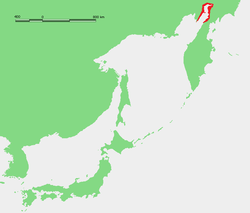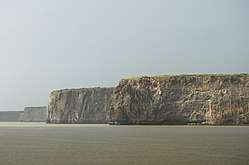Penzhina Bay
Penzhina Bay (Russian: Пе́нжинская губа́, Penzhinskaya guba) is a long and narrow bay off the northwestern coast of Kamchatka, Russia.


Geography
Penzhina Bay is the upper right arm of Shelikhov Bay in the northeastern corner of the Sea of Okhotsk. It is bounded on the east by the Kamchatka Peninsula and on the west by the Taygonos Peninsula, which separates it from Gizhigin Bay. It is about 300 km (186 mi) long and 65 km (40 mi) wide. Near its middle two peninsulas narrow it to 30 km (18.6 mi). There is ice in the bay from October to May. It has the highest tides of any bay on the Pacific Ocean: 9 m (29.5 ft), 12.9 m (42.3 ft) maximum, versus 17 m (56 ft) in the Bay of Fundy. Its basin is very thinly populated.
The river Penzhina flows into the head of the bay. It is 713 km (443 mi) long and flows east, then south, then southwest to reach the bay.
History
The town of Penzhina was located on the middle Penzhina River and was visited by George Kennan in 1866. The major tributary of the Penzhina is the Aklan, Oklan or Khayakha River which flows southeast and joins the Penzhina about 50 miles from its mouth.
In 1669 the Russians built the ostrog of Aklansk, which was used to subdue the local Koryaks and was an important base on the route south from Anadyrsk to the Kamchatka peninsula before the sea route from Okhotsk opened up. It was attacked by the Koryaks several times and later abandoned.
Between 1849 and 1900, American whaleships hunted bowhead whales in the bay.[1][2][3] On 11 August 1867, the barque Stella (270 tons), of New Bedford, Capt. Ebenezer F. Nye, was wrecked on Krayny on the western side of the bay. Two men were killed as the barque was smashed to pieces. The rest of the crew were rescued by several nearby vessels.[4][5][6]
During a five-day period in late September 1968, the Soviet factory ship Vladivostok and its fleet of whale catchers illegally caught sixty-six balaenids (likely bowheads) in the bay.[7]
See also
References
- Mary and Susan, of Stonington, July 23, 1849, Nicholson Whaling Collection (NWC); Coral, of New Bedford, July 28-Aug. 7, 1852, NWC; Florida, of Fairhaven, July 30-Aug. 2, 1861, One Whaling Family (Williams 1964); Arnolda, of New Bedford, July 7, 27–29, 1874, Old Dartmouth Historical Society; Mary and Helen II, of San Francisco, June 9 – July 6, July 8-Aug. 3, 1885, Kendall Whaling Museum.
- Jochelson, W. (1905). "The Koryak". The Jesup North Pacific Expedition, Vol. VI. Memoirs of the American Museum of Natural History. Leiden/New York.
- Allen, J. A. (1903). "Report of the mammals collected in northeastern Siberia by the Jesup North Pacific expedition with itinerary and field notes, by N. G. Buxton". Bulletin of the American Museum of Natural History, Vol. XIX, pp. 101-184.
- Sea Breeze, of New Bedford, Aug. 15, 1867, ODHS.
- Whalemen's Shipping List and Merchants' Transcript (Vol. XXV, No. 35, Oct. 29, 1867, New Bedford).
- Starbuck, Alexander (1878). History of the American Whale Fishery from Its Earliest Inception to the year 1876. Castle. ISBN 1-55521-537-8.
- Ivashchenko, Y. V. & P. J. Clapham. (2012). "Soviet catches of right whales Eubalaena japonica and bowhead whales Balaena mysticetus in the North Pacific Ocean and the Okhotsk Sea". Endang. Species Res., Vol. 18: 201–217.